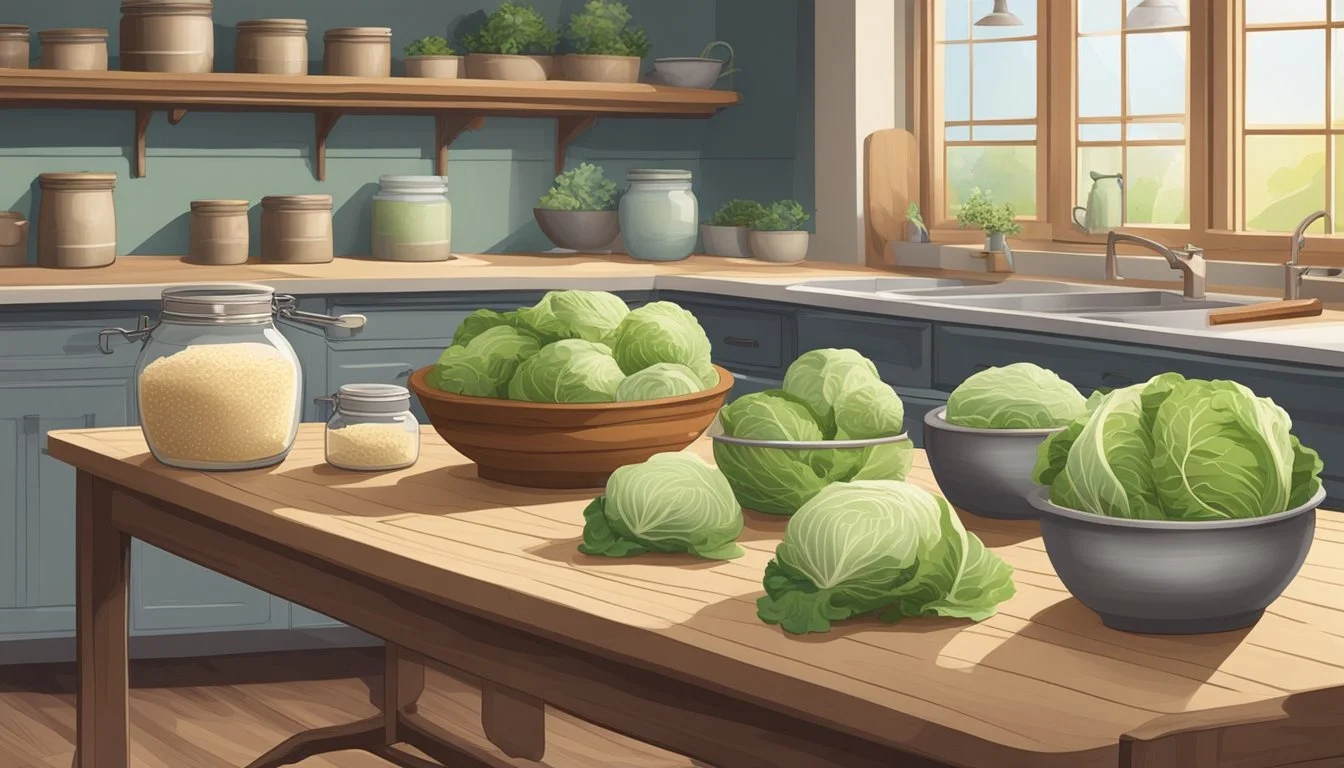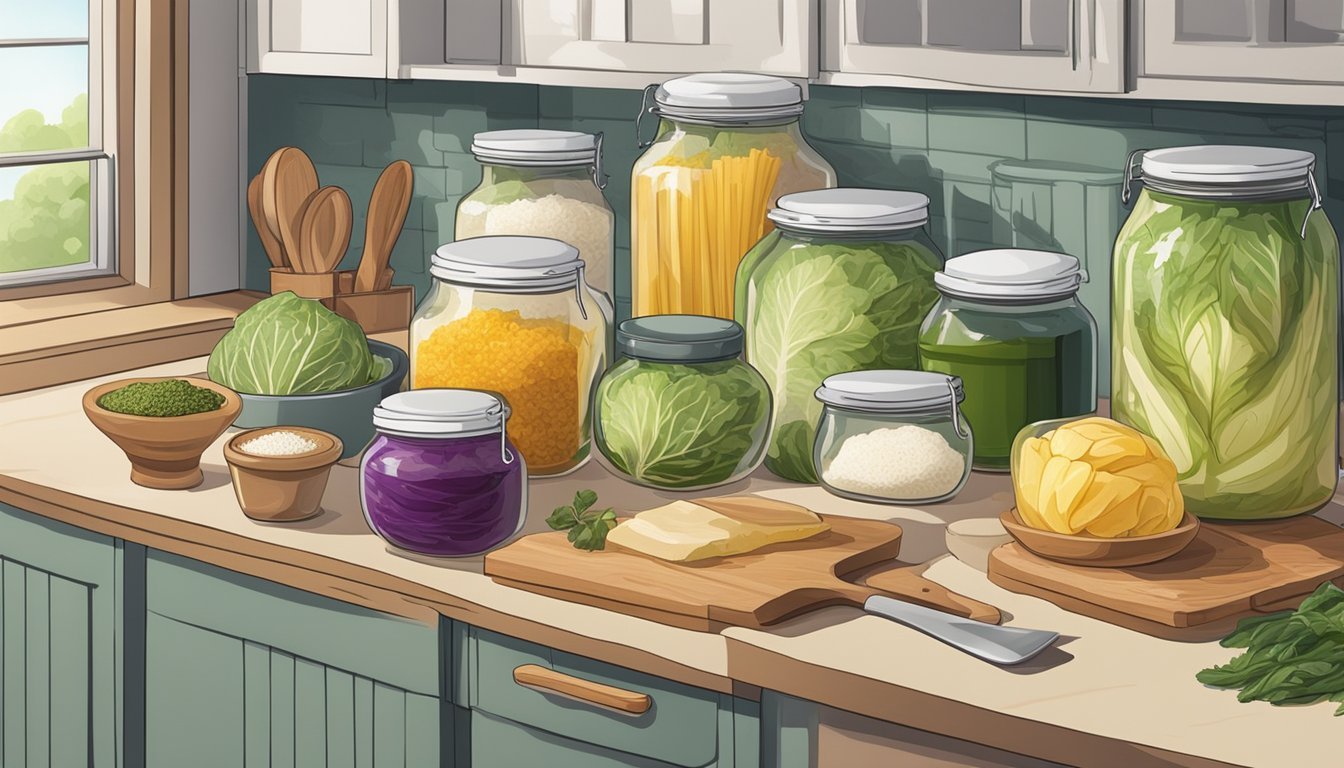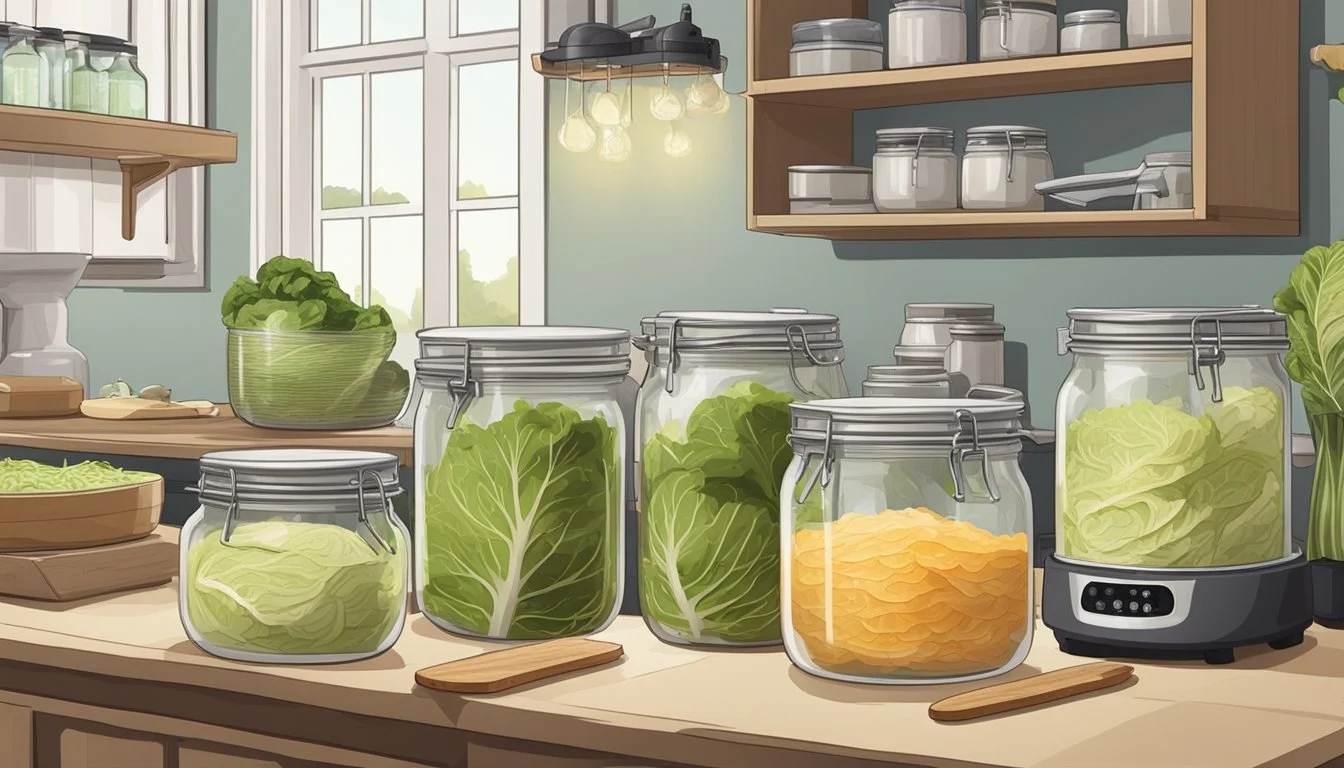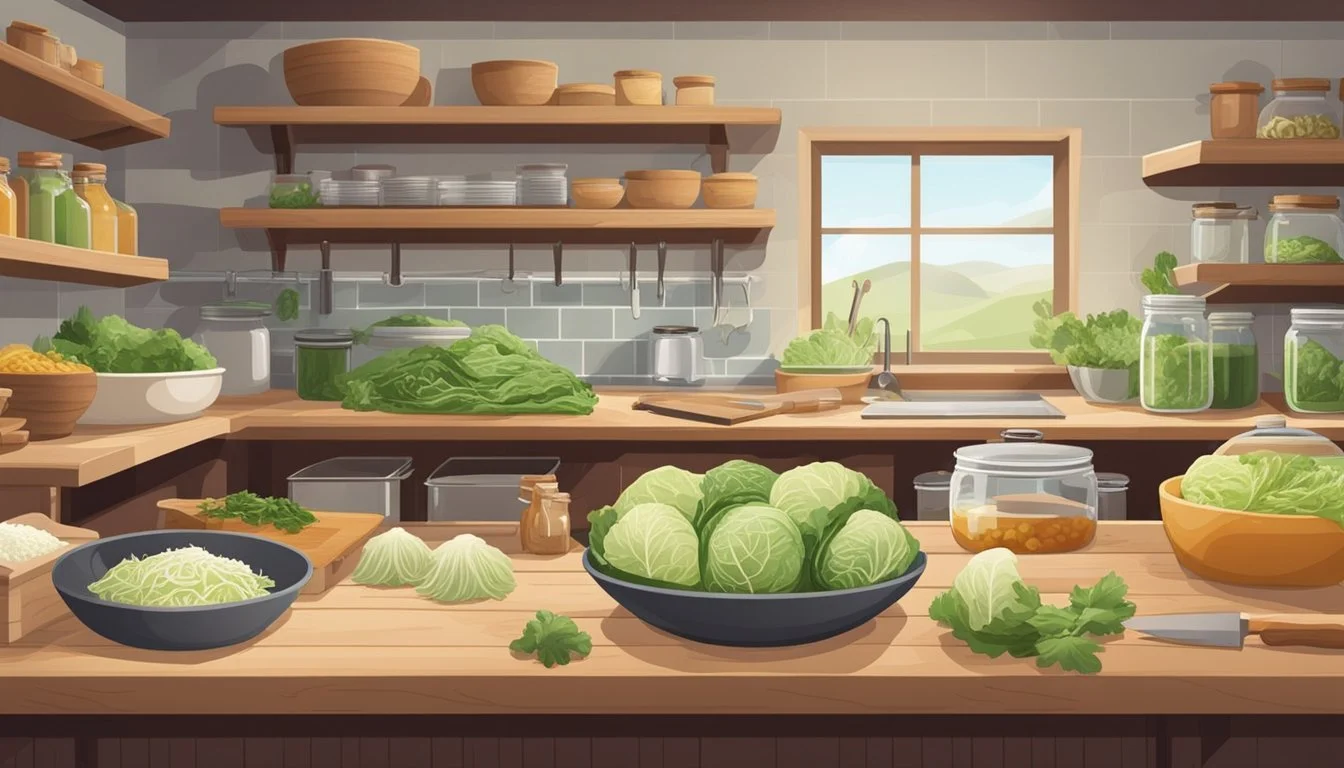How to Create an Organized Kitchen Sauerkraut Making Station
A Step-by-Step Guide
Making sauerkraut at home requires organization and precision. An organized kitchen station dedicated to fermentation can streamline the process, making it more efficient and enjoyable. The key to successful homemade sauerkraut lies in creating an environment where cleanliness meets accessibility. Sauerkraut, a product of fermentation, is created when cabbage is mixed with salt and then left to ferment over a period of time under the right conditions.
Setting up a kitchen station for sauerkraut involves selecting the right tools and ingredients. Essential items include a large mixing bowl, a reliable scale for accurate measurements, quality salt, and a suitable fermentation vessel. The right type of salt can influence the fermentation process, making it critical to choose one that does not contain additives that could impede bacterial growth. Airlocks, weights to keep the cabbage submerged, and canning jars are also integral to the setup.
The physical arrangement of these items should prioritize ease of use and hygienic practices. Organizing tools and ingredients on a tray or dedicated space ensures they are readily available when needed. This setup not only helps maintain cleanliness by containing the workspace to a specific area but also aids in monitoring the sauerkraut as it ferments. By paying attention to these details, enthusiasts can look forward to a successful batch of sauerkraut that is both rewarding to create and delicious to consume.
Fundamentals of Sauerkraut Making
Creating sauerkraut requires an understanding of fermentation, selection of quality ingredients, and the use of salt for successful lacto-fermentation.
Understanding Fermentation
Fermentation is the metabolic process where natural bacteria feed on the sugar and starch in the food creating lactic acid. This process preserves the cabbage and gives sauerkraut its distinct sour flavor. Lacto-fermentation, in particular, involves lactic acid bacteria that thrive in an anaerobic (oxygen-free) environment which is essential for the successful transformation of raw cabbage into sauerkraut.
Choosing the Right Ingredients
The key ingredient in sauerkraut is cabbage. Choosing fresh, organic cabbage is vital as it is rich in natural sugars necessary for fermentation. Additionally, including a variety of vegetables can enhance the flavor and nutritional content, introducing beneficial probiotics which support digestive health.
The Role of Salt in Sauerkraut
Salt serves several important functions in the making of sauerkraut:
Preservation: It inhibits the growth of undesirable bacteria, molds, and yeasts.
Flavor: It enhances the overall taste of the sauerkraut.
Texture: It helps maintain the crunchiness of the cabbage by drawing out water and creating brine.
A recommended ratio is 3 tablespoons of sea salt per 5 pounds of shredded cabbage. Sea salt is preferred for its mineral content and lack of additives. The right amount of salt ensures a conducive environment for lactic acid bacteria to ferment the cabbage effectively.
Equipment Essentials
Creating an organized kitchen sauerkraut making station requires selecting the right equipment to ensure a successful fermentation process. High-quality tools not only make the task easier but also contribute to the final flavor and texture of the sauerkraut.
Selecting the Proper Jars and Weights
Jars:
The ideal container for sauerkraut fermentation is a glass mason jar; its transparent nature allows for monitoring the fermentation process. A wide-mouth mason jar is particularly user-friendly, accommodating larger cabbage pieces and facilitating easy packing.
Weights:
To keep cabbage submerged below the brine and promote an anaerobic environment, one should select appropriate fermentation weights. Glass weights are often preferred as they are non-porous, easily sanitized, and do not react chemically with the fermenting sauerkraut.
Additional Tools for Preparation
Knife and Mixing Bowl:
A sharp knife is necessary for finely slicing the cabbage, while a large mixing bowl provides ample space for mixing cabbage with salt before packing it into jars.
Kraut Pounder:
A wooden kraut pounder, tailored for use in smaller jars, is an invaluable tool when it comes to tightly packing the kraut into the jar and releasing its natural juices, which form the brine.
Maintaining an Anaerobic Environment
Fermentation Lids:
For mason jars, one may use specially designed fermentation lids that allow gases to escape while preventing air from entering. These lids are crucial in maintaining an anaerobic environment, which is essential for proper fermentation and preventing mold growth.
Airlocks:
An airlock system can also be used in conjunction with a lid to ensure that carbon dioxide can escape the jar while oxygen and contaminants are kept out, preserving the sauerkraut's taste and preventing spoilage.
Preparing the Cabbage
Proper preparation of the cabbage is essential for sauerkraut making. It involves thorough cleaning, precise slicing, and the right salt brine for successful fermentation.
Cleaning and Slicing Techniques
One begins by selecting a fresh green cabbage or red cabbage. It must be clean before slicing; run it under cold water to remove any dirt or debris. Any wilted outer leaves should be removed and discarded. For slicing, a mandolin slicer or a sharp knife can achieve the desired thinness. Uniform, thin strips are crucial for consistent fermentation.
Tools: Mandolin slicer, knife
Objective: Even, thin slices for consistency
Creating the Salt Brine
The next step is to create a salt brine that will encourage fermentation. The ideal ratio is 1 teaspoon of salt to 1 cup of water. This salt brine should be made with non-iodized salt to avoid impurities that can hinder fermentation. After mixing, one must ensure that the salt is completely dissolved in the water.
Ratio: 1 teaspoon salt : 1 cup water
Type of salt: Non-iodized
Mixing for Optimal Fermentation
The sliced cabbage is then layered with salt in the fermentation vessel, which draws out moisture. Through mixing, the cabbage begins to wilt and release liquid, creating its own brine. If the cabbage does not release enough liquid to submerge it fully, one can add the prepared salt brine until all pieces are covered. The right amount of salt and thorough mixing will set the stage for optimal fermentation.
Process: Alternate layers of sliced cabbage and salt
Indicator: Cabbage submerged in its own liquid
Organizing the Kitchen Station
The success of a kitchen sauerkraut making station depends on a functional layout and accessible storage for ingredients and tools. Proper organization ensures efficiency and ease during the fermentation process.
Layout for Efficiency
When organizing a kitchen station for sauerkraut, one should aim for a layout that minimizes movement and maximizes convenience. A kitchen island or spacious countertop provides ample workspace and can serve as the central hub. Open shelves or a kitchen nook positioned above or beside the workstation allow for easy access to necessary equipment. The layout should be designed to follow the natural progression of sauerkraut preparation: from washing and cutting the vegetables to brining and fermenting.
Essential Zones within the Kitchen Station:
Preparation Zone: A clear, clean countertop for slicing cabbage and mixing ingredients.
Mixing and Brining Zone: Space allocated for combining salt and cabbage to create the brine.
Fermentation Zone: An area on the countertop or shelving where mixed ingredients can rest and ferment, undisturbed.
Storing Ingredients and Tools
Ingredients: Sauerkraut requires a few key ingredients that should be stored for freshness and easy access.
Cabbage: Store whole cabbage in a cool, dry place until ready to use.
Salt: Keep in a dry, easily accessible spot, such as a salt cellar on the kitchen island.
Spices (if used): Place frequently used spices like caraway seeds in small containers or organizers on open shelves for quick reach.
Tools: Each tool should have its designated space. Organizers can help maintain tidiness and prevent clutter.
Knives and Cutting Boards: Store these on magnetic strips or in drawers immediately beneath the preparation zone for instant access.
Mixing Bowls: Stack them neatly on open shelves or inside cabinets near the brining area.
Fermenting Jars/Crocks: Position these within the fermentation zone to transfer the brine and cabbage mixture effortlessly.
By arranging each component systematically, one creates an efficient kitchen station tailored for sauerkraut preparation.
The Fermentation Process
Fermentation is a critical stage in sauerkraut production where the environment needs to be controlled to transform cabbage into a flavorful, probiotic-rich food. Maintaining proper timing, temperature, and vigilance for mold are essential steps one must monitor to ensure successful fermentation.
Timing and Temperature
Timing: The fermentation time for sauerkraut typically ranges from 3 to 6 weeks, with taste tests advisable after the third week to gauge readiness.
Temperature: It thrives best at a stable temperature range of 65°F to 72°F (18°C to 22°C). Temperatures that are too high can accelerate fermentation but may lead to spoilage, while too low temperatures can slow down the process.
Monitoring for Mold and Proper Fermentation
One should inspect their sauerkraut regularly for signs of mold, which can appear if the cabbage is not fully submerged in brine or if there are impurities.
Mold Detection: Look for white scum or colored mold. White scum can often be skimmed off without issue, but colored mold indicates spoilage, and the batch should be discarded.
Fermentation Signs: Proper fermentation is indicated by bubbles, a tangy smell, and the presence of lactic acid bacteria, confirming the creation of sauerkraut.
For storage, it's advised to place the sauerkraut in a cool, dark place or refrigerate it to halt fermentation, which allows for a serving with consistent taste and quality over time.
Finishing and Flavoring
Creating an organized kitchen sauerkraut making station streamlines the process of fermenting cabbage into a flavorful delicacy. This section covers how to enhance the taste of homemade sauerkraut with spices and test for doneness.
Adding Spices and Flavor Variations
Once the basic sauerkraut fermentation is underway, one can introduce a variety of spices and flavors to customize the recipe. Garlic is commonly added, either finely sliced or chopped, to infuse a pungent taste. For a hint of sweetness, fennel can be shredded and mixed in. To incorporate a unique flavor and vibrant color, grated beets are an excellent choice. They should be aware that beets will change the sauerkraut to a vivid pink hue.
Here are recommended spices and flavor additions:
Garlic: 2-4 cloves, finely chopped
Fennel: 1 small bulb, cored and shredded
Beets: 1 medium beet, grated
For a tangy twist, some like to add apples, shredded into the mixture. If they're adventurous and enjoy a Korean kick, incorporating elements of kimchi, such as Korean chili flakes, ginger, and spring onions, can transition the taste from traditional German to Asian fusion.
Testing for Doneness
They should begin taste testing their sauerkraut after the primary fermentation period, typically around the 3-week mark. The sauerkraut should taste tart with a slight crunch. If the sauerkraut tastes too salty or has not developed enough acidity, it may need more time to ferment.
A simple test for doneness is as follows:
Visual Inspection: The sauerkraut should appear slightly translucent and reduced in volume. There should be no visible mold.
Taste Test: Sample a small amount. It should be pleasantly sour and still have some crunch.
Once the sauerkraut passes these tests and meets the desired flavor profile, it is ready to be removed from the fermentation vessel, packed into jars, and stored in the refrigerator to halt the fermentation process. Continual taste testing is key in achieving their preferred balance of flavors.
Serving and Storage
After mastering the craft of homemade sauerkraut, the final touch is ensuring it's served correctly and stored efficiently to preserve freshness. This section serves as a guide to enjoying sauerkraut at its best and keeping it well-preserved for future use.
How to Serve Homemade Sauerkraut
Homemade sauerkraut can be served raw or cooked, complementing a variety of dishes. When served raw, it retains more of its probiotic benefits. It adds a distinctive tangy flavor to salads, sandwiches, or as a side dish. For cooked dishes, gently warm it to maintain its texture and flavor. Always use clean utensils to avoid contamination.
Proper Storage Practices
Storage is crucial for maintaining the sauerkraut’s quality and extending its shelf life. There are different methods suitable for canned sauerkraut and that which is stored in the refrigerator or root cellars:
Refrigeration: For short to medium-term storage, keep sauerkraut in the refrigerator in an airtight container. This method is suitable for keeping raw sauerkraut crisp and fresh for several months.
Canning: To preserve sauerkraut for longer periods, it may be canned. This process involves placing the sauerkraut in sterilized jars and sealing them with airtight lids to prevent spoilage. Properly canned sauerkraut can last for about 12 to 18 months.
Root Cellars: Those who prefer traditional methods can utilize root cellars for cool, stable temperatures, making it ideal for the slow fermentation and storage of sauerkraut for a few months. Ensure that containers are sealed to prevent unwanted odors and contamination.
By following these serving suggestions and storage practices, sauerkraut can be enjoyed in its best form as a nutritious and delicious addition to meals.
Health Benefits of Sauerkraut
Sauerkraut is known for its impressive health benefits, particularly due to its high probiotic content and its role as an immune booster. This fermented food not only adds flavor but also contributes to overall health.
Probiotics and Gut Health
Sauerkraut is rich in probiotics, the beneficial bacteria that play an essential role in maintaining gut health. These live microorganisms can help balance the intestinal flora, aiding in digestion and the absorption of nutrients.
Probiotics in Sauerkraut:
Improve digestive function
Help prevent the overgrowth of harmful bacteria
The process of fermenting sauerkraut encourages the growth of these probiotics, which are crucial in maintaining a healthy gut environment.
Vitamin C and Immune Boosting Properties
Vitamin C is a vital nutrient found abundantly in sauerkraut, and it acts as a powerful immune booster. This antioxidant helps in protecting the body against illnesses and enhances the immune system's effectiveness.
Role of Vitamin C:
Supports the immune system to guard against infections
Encourages the production of white blood cells, which are central to fighting off pathogens
By integrating sauerkraut into a diet, one can tap into the benefits of vitamin C, which is enhanced through the fermentation process that increases its bioavailability.
Incorporating Sauerkraut into Meals
When discussing the culinary versatility of sauerkraut, it's important to consider both innovative recipes and traditional pairings. Sauerkraut can elevate a variety of dishes, from family favorites to casual dining options.
Recipes Beyond the Basic Sauerkraut
Sauerkraut Mashed Potatoes: Infuse a tangy twist into the classic mashed potato recipe by blending in sauerkraut. This combination can enhance the dish, giving it a unique flavor profile and added nutritional benefits.
Sauerkraut Dumplings: Stuff homemade dumplings with a hearty mixture of sauerkraut and ground sausage for a savory meal that pays homage to Eastern European traditions.
Sauerkraut Pizza: Top a crisp pizza crust with a generous helping of sauerkraut alongside traditional ingredients such as cheese and tomato sauce, or experiment with unconventional toppings to create a gourmet experience.
Pairings and Serving Suggestions
Traditional Dish Sauerkraut Pairing Grilled Sausage Serve sauerkraut on the side as a condiment Reuben Sandwich Incorporate sauerkraut directly into the sandwich for an authentic taste Pork Chops (What wine goes well with pork chops?) Top with a spoonful of sauerkraut for a complementary zesty flavor
Cheese Boards: Include sauerkraut as a tangy counterpoint on a cheese board arrangement, paired with strong cheeses and cured meats (What wine goes well with cured meats?) to balance the flavors.
Salads: Use sauerkraut to add crunch and zing to a green salad, or create a sauerkraut coleslaw as a side dish for barbecue meals and picnics.
Conclusion
Setting up an organized kitchen for sauerkraut production streamlines the process and enhances the joy of creating homemade ferments. Users should ensure that all necessary tools and ingredients are at hand for efficient sauerkraut preparation.
A systematic approach also involves:
Preparation: Shredding cabbage uniformly and salting it accurately,
Fermentation: Providing an ideal environment and monitoring progress,
Storage: Selecting the right containers for long-term preservation.
An organized kitchen station supports enthusiasts in crafting sauerkraut with confidence, fostering a satisfying DIY experience. It’s important that they trust the process, give their cabbage the care it needs, and adjust for variables like temperature and batch size.
Lastly, the creation of homemade sauerkraut isn't just a culinary endeavor—it's a venture into the world of probiotics and tradition. One can take pride in preserving an age-old craft while nurturing personal health and kitchen creativity.
Embrace the mastery of the craft, and delight in the tangy, crisp final product of one's own making.











